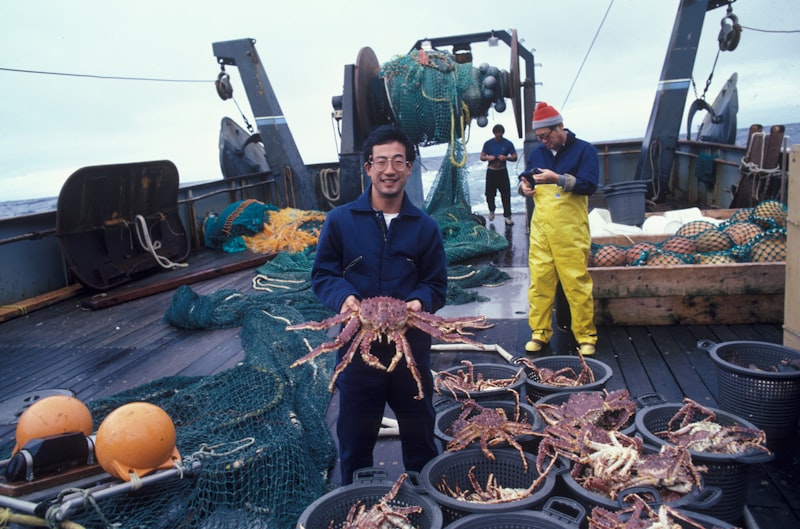In marine biology, understanding the genetic makeup of species is pivotal for conservation efforts, ecological studies, and even pharmaceutical discoveries. Bioinformatics tools enable researchers to sequence and analyze genomes of marine organisms, revealing insights into their evolutionary history, adaptation mechanisms, and genetic diversity. For instance, by decoding the genome of a marine species, scientists can identify genes responsible for unique adaptations to extreme oceanic environments or uncover potential biomarkers for marine diseases.
Moreover, bioinformatics facilitates the study of marine ecosystems on a broader scale. Researchers can analyze environmental DNA (eDNA) samples to assess biodiversity in oceans without directly observing organisms. This method helps monitor endangered species, invasive species, and overall ecosystem health more efficiently.
In practical terms, bioinformatics platforms and databases are indispensable for marine biologists. They provide tools for genome assembly, sequence alignment, phylogenetic analysis, and predicting protein structures. These tools empower researchers to extract meaningful biological insights from complex genetic data swiftly and accurately.
Furthermore, bioinformatics accelerates the discovery of novel marine natural products with pharmaceutical potential. By mining genomic data from marine organisms, scientists can identify genes responsible for producing bioactive compounds. These discoveries contribute to developing new drugs, antibiotics, and other biotechnological applications derived from marine sources.
Overall, bioinformatics is transforming marine biology by enhancing our understanding of marine life at the molecular level. It enables researchers to tackle complex biological questions, drive conservation efforts, and harness marine resources sustainably for the benefit of both science and society.
Unlocking the Secrets of the Deep: Bioinformatics Revolutionizes Marine Biology

Imagine diving into the ocean’s depths, where sunlight fades and pressure mounts, revealing an alien world teeming with life. This realm has long fascinated scientists, yet its secrets have remained elusive. Now, with bioinformatics, they can decode the genetic blueprints of marine organisms with unprecedented precision. Every species holds a unique genetic signature, a digital fingerprint that tells a story of adaptation and survival in the harsh underwater environment.
From the microscopic plankton to majestic whales, each creature’s genome offers clues to its evolution and ecological role. Bioinformatics algorithms sift through vast datasets, identifying genes responsible for resilience to temperature changes, resistance to diseases, or even production of compounds with potential biomedical applications.
In practical terms, bioinformatics allows researchers to predict how marine ecosystems might respond to climate change, pollution, or overfishing. By analyzing DNA sequences extracted from water samples or marine organisms, scientists can monitor biodiversity trends in real-time, guiding conservation efforts and sustainable management practices.
Moreover, this field transcends mere exploration—it fosters collaboration across disciplines. Marine biologists, geneticists, and computer scientists work hand in hand, pooling expertise to unravel complex biological puzzles. Together, they harness computational power to simulate ecological scenarios, model evolutionary trajectories, and even design novel marine-inspired technologies.
As our understanding deepens, bioinformatics promises to unveil new species, rewrite evolutionary histories, and inspire innovations that benefit both marine conservation and human health. The ocean, once a realm of mystery, is now yielding its secrets to the power of data-driven science.
From Genome to Ocean: How Bioinformatics Reshapes Marine Research
At its core, bioinformatics analyzes vast amounts of genetic information extracted from marine organisms. Researchers sequence DNA, RNA, and proteins from diverse species found in oceans worldwide. These sequences serve as a blueprint, revealing evolutionary relationships, genetic adaptations, and biological functions unique to marine life forms.
Imagine bioinformatics as a powerful magnifying glass, zooming into the intricacies of marine genomes. It deciphers how organisms thrive in extreme environments like deep-sea hydrothermal vents or polar ice caps. By comparing genomes across species, scientists identify genes responsible for adaptations such as salt tolerance in marine plants or bioluminescence in deep-sea creatures.
Moreover, bioinformatics enables researchers to track marine biodiversity and understand ecosystem dynamics. Through metagenomics, scientists study entire communities of marine microbes without needing to culture each species individually. This approach unveils hidden microbial diversity and their roles in nutrient cycling, carbon sequestration, and even climate regulation.
In practical terms, bioinformatics accelerates drug discovery from marine organisms. Researchers explore natural compounds produced by marine microbes or invertebrates, potentially yielding new antibiotics, antivirals, or anticancer agents. These discoveries are crucial as traditional sources of pharmaceuticals face challenges.
Furthermore, bioinformatics supports conservation efforts by monitoring endangered species and understanding their genetic health. By mapping genomes of threatened marine species, conservationists develop strategies for sustainable fisheries management and marine protected areas.
Bioinformatics transforms marine research into a data-driven exploration of the ocean’s genetic richness. It empowers scientists to navigate uncharted waters, uncovering biological treasures that hold promise for medicine, conservation, and a deeper understanding of our planet’s blue heart.
Oceanic Codebreakers: Bioinformatics Pioneers Marine Conservation Efforts
Imagine a team of modern-day codebreakers, but instead of deciphering cryptic messages, they’re unraveling the complex genetic codes of marine organisms. Their tools are not just pens and paper, but advanced computer algorithms and massive datasets collected from the depths of the ocean.
Bioinformatics, at its core, is the marriage of biology and computer science. It allows scientists to analyze vast amounts of biological data, such as DNA sequences from marine organisms, and derive meaningful insights that can inform conservation efforts. This approach is crucial because it helps scientists understand not only the current state of marine biodiversity but also how it is changing over time.
One of the key challenges in marine conservation is understanding the interconnectedness of species within ecosystems. Bioinformatics helps scientists map out these intricate relationships by studying genetic similarities and differences among species. This knowledge is vital for identifying vulnerable species, predicting their responses to environmental changes, and designing targeted conservation strategies.
Think of bioinformatics as a powerful magnifying glass that allows scientists to zoom in on the microscopic world of marine genetics. By studying the genetic makeup of corals, fish, and other marine organisms, researchers can uncover hidden patterns and connections that are essential for effective conservation planning.
Moreover, bioinformatics is not just about decoding genetic sequences; it’s also about sharing knowledge and collaborating across borders. Scientists around the globe can access and analyze shared databases, accelerating research and conservation efforts on a scale never before possible.
Big Data Meets Blue Planet: Bioinformatics Tools Transform Marine Ecology

In the vast expanse of the ocean, countless species thrive, each playing a crucial role in maintaining the delicate balance of marine ecosystems. However, studying these organisms and their environments has always been challenging due to the sheer scale and complexity of the oceans. Here’s where Big Data steps in as a game-changer.
By collecting massive amounts of data from various marine environments, including genomic sequences, environmental parameters, and species distributions, scientists can now create comprehensive models of marine ecosystems. These models not only help in understanding the biodiversity hotspots but also predict how these ecosystems might respond to environmental changes such as climate change or pollution.
Imagine bioinformatics tools as high-tech translators that decode the language of marine life. They analyze DNA sequences extracted from seawater samples or marine organisms to identify species, track their movements, and even uncover new species that were previously unknown to science. It’s like exploring a vast underwater library where each DNA sequence is a unique story waiting to be told.
Moreover, Big Data allows researchers to collaborate globally, sharing datasets and insights that transcend geographical boundaries. This collaborative effort is essential for tackling pressing issues like overfishing, habitat destruction, and the impact of human activities on marine biodiversity.
Mapping the Sea’s DNA: Bioinformatics Unveils Hidden Marine Biodiversity
Exploring the depths of the ocean has always been an endeavor that captures the imagination. Yet, beneath the waves lies a world teeming with life, much of it still a mystery to us. Bioinformatics, a cutting-edge field at the intersection of biology and computer science, is now revolutionizing our understanding of marine biodiversity.
Imagine the ocean as a vast library, each species a unique book waiting to be discovered. Traditional methods of studying marine life often relied on visual identification, which can be challenging in the murky depths where many species dwell. Bioinformatics changes this game by analyzing the genetic material of organisms extracted directly from seawater samples. It’s akin to reading the DNA blueprint of the entire ocean ecosystem, revealing species that were previously invisible to conventional methods.
This approach not only accelerates the pace of discovery but also provides a more comprehensive view of marine biodiversity. By deciphering the genetic code present in seawater, scientists can identify species that may be rare, elusive, or entirely new to science. It’s like finding hidden treasures in a vast and uncharted sea.
Moreover, bioinformatics doesn’t just stop at identifying species. It allows researchers to understand how these organisms interact with their environment, adapt to changing conditions, and contribute to the overall health of marine ecosystems. It’s as if we’re unraveling the intricate threads of a tapestry, each thread representing a unique species playing its part in the web of ocean life.
The implications of this technology are profound. Conservation efforts can be better targeted, focusing on protecting not just visible species but entire genetic pools that sustain marine biodiversity. It’s like having a map that reveals not only the surface features of the ocean but also its hidden depths and unseen pathways.
Bioinformatics is transforming marine biology by unlocking the secrets hidden within the sea’s DNA. It’s a journey of discovery that promises to reveal new species, redefine our understanding of marine ecosystems, and inspire future generations to explore and protect our planet’s most precious resource—the ocean.
Frequently Asked Questions
What Tools Are Used in Marine Bioinformatics?
Discover the essential tools used in marine bioinformatics, vital for analyzing biological data from marine environments. Learn about specialized software, databases, and computational methods tailored to marine biology research.
How Does Bioinformatics Benefit Marine Research?
Learn how bioinformatics enhances marine research by enabling the analysis of vast biological data sets from marine organisms. Discover how it aids in understanding marine ecosystems, biodiversity, and the impact of environmental changes, ultimately supporting conservation efforts and sustainable ocean management.
How is Bioinformatics Applied to Marine Species Conservation?
Discover how bioinformatics aids in marine species conservation by leveraging genomic data to understand population dynamics, genetic diversity, and adaptation to environmental changes. It enables informed conservation strategies for protecting endangered species and preserving marine ecosystems.
What Are the Career Opportunities in Marine Bioinformatics?
Explore career opportunities in marine bioinformatics, blending marine biology with computational analysis. Discover roles in genomic research, environmental monitoring, and conservation efforts. Dive into data-driven careers that bridge marine science with cutting-edge technology.
What is Bioinformatics in Marine Biology?
Bioinformatics in Marine Biology combines computational methods with biological data to study marine organisms and ecosystems. It helps researchers analyze genetic sequences, model ecological interactions, and understand biodiversity in marine environments.


